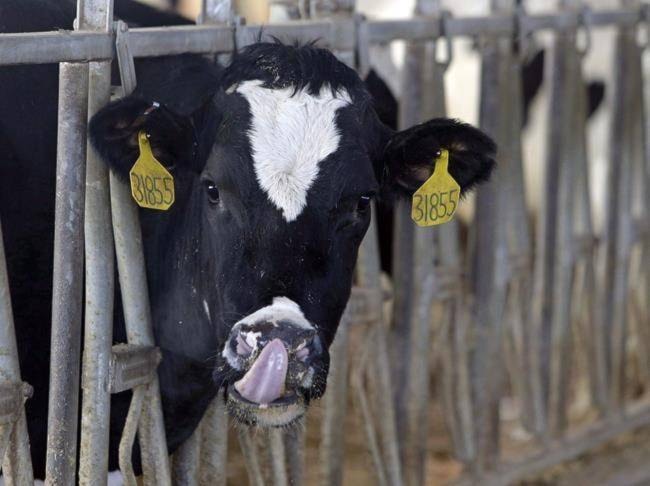More Canadians have likely slathered their late-summer corncobs with American-made butter in recent years B��Ԫ������ַ� and it had nothing to do with U.S. President Donald TrumpB��Ԫ������ַ�s demands for more access to CanadaB��Ԫ������ַ�s dairy market.
The countryB��Ԫ������ַ�s protected market has been a key sticking point between Ottawa and Washington during the tense renegotiation of the North American Free Trade Agreement. Throughout the process, Trump has made repeated calls for Canada to let in more American dairy products.
U.S. farmers recently enjoyed extra access to the Canadian market B��Ԫ������ַ� and, in this instance, the opportunity came because of CanadaB��Ԫ������ַ�s controversial protective system known as supply management.
Butter imports from the U.S. nearly quadrupled between 2015 and 2016 to help satisfy CanadiansB��Ԫ������ַ� sudden surge in demand for the creamy product that domestic producers couldnB��Ԫ������ַ�t immediately keep up with. Canada wasnB��Ԫ������ַ�t alone B��Ԫ������ַ� butter sales saw strong growth in many parts of the world.
To satiate the rapidly expanding appetites of Canadian butter lovers, the federal government approved a request to temporarily open its doors to more imports above the usual quota. Due to proximity, lots of it rolled in from the U.S.
After shipping 2,275 tonnes of butter to its northern neighbour in 2015, the U.S. sold 8,266 tonnes here in 2016 and 8,672 tonnes last year, according to Statistics Canada. From 2008 to 2014, the figures show annual U.S. butter imports fluctuated between 1,069 and 4,482 tonnes.
The recent influx of American butter also boosted CanadaB��Ԫ������ַ�s stockpiles, which expanded to 44,708 tonnes in July 2018 from 11,571 tonnes in January 2017.
Critics have long argued supply management leaves Canadians with fewer choices in the supermarket, leads to higher prices for consumers and stifles innovation in the industry.
When it comes to butter, some say the fact Canada had to increase U.S. imports in a time of need points to another key downside.
Domestic producers, they maintain, cannot respond quickly to surges in demand because theyB��Ԫ������ַ�re hindered by the systemB��Ԫ������ַ�s strict rules. There are also concerns that thereB��Ԫ������ַ�s too much focus on the Canadian market, rather than a push to expand deeper into the global market.
But defenders of the system insist the recent boosts in U.S. butter imports show why itB��Ԫ������ַ�s so effective.
B��Ԫ������ַ�That is the supply-managed system B��Ԫ������ַ� you make sure your market is getting the milk and dairy products it needs without overproduction and without dumping products,B��Ԫ������ַ� said Graham Lloyd, general manager and CEO of the Dairy Farmers of Ontario.
B��Ԫ������ַ�Because we manage the amount of milk production to meet the domestic market requirements, it takes time to ramp up and sometimes to ramp down. So, when thereB��Ԫ������ַ�s shortages we want to import B��Ԫ������ַ� to make sure we service the market.B��Ԫ������ַ�
The quotas protect the Canadian market from an influx of milk products in the U.S., where thereB��Ԫ������ַ�s vast amounts of oversupply. Many warn that opening the floodgates to American milk products would overwhelm CanadaB��Ԫ������ַ�s market and put a large number of farms out of business.
The sudden need for more butter a few years ago led the Canadian Dairy Commission to request supplementary import permits for thousands of tons of the product. Under normal circumstances, a World Trade Organization agreement signed by Canada says it must import 3,274 tonnes of butter from around the world every year and much of it has come from the U.S.
Lloyd and other industry leaders say Canadian producers caught up to the increased demand by late 2017 and thereB��Ԫ������ַ�s no longer a need for extra butter imports beyond the WTO quota.
B��Ԫ������ַ�We can say that the system is working well, this is why we defend it firmly B��Ԫ������ַ� because itB��Ԫ������ַ�s a good system,B��Ԫ������ַ� said Pierre Lampron, president of the Dairy Farmers of Canada.
But experts like Sylvain Charlebois, a food distribution and policy professor at Dalhousie University, said the fact Canada had to raise its butter-import levels is an example of whatB��Ԫ������ַ�s wrong with supply management.
He argued the market would be more flexible if supply management didnB��Ԫ������ַ�t exist because it forces producers to obey specific rules and prices. In times of rising demand, producers are left with fewer options to adjust, he added.
The mechanism, Charlebois said, also fails to support an economic growth agenda.
B��Ԫ������ַ�Demand for butter is up everywhere around the world B��Ԫ������ַ� and we donB��Ԫ������ַ�t have a system in place to take advantage of that,B��Ԫ������ַ� Charlebois said.
B��Ԫ������ַ�So, we are importing more butter to supply Canadians, but what about opportunities elsewhere?B��Ԫ������ַ�
Canada exported about 16 tonnes of butter to the U.S. in 2015, 75 tonnes in 2016 and 19 tonnes in 2017, according to Statistics Canada.
Supply management dates from the 1970s and was part of an effort to stabilize dairy prices by limiting imports and setting fixed prices. It has been emulated by other industries, including chicken, eggs and turkey.
The regime has been front and centre at the NAFTA bargaining table.
Concerns in Canada that NAFTA could fall apart over the protected dairy market has lit a fire under a long-running domestic debate over whether to keep the system intact.
Prime Minister Justin Trudeau has promised to maintain the system against U.S. calls for greater access. Sources say Ottawa has offered some limited concessions on access, but has defended the supply management system itself.
Adam Plater, an independent agricultural trader and analyst, came across the numbers that show the recent increases in U.S. butter imports and in CanadaB��Ԫ������ַ�s inventories.
Plater believes more transparency is needed around how storage levels are determined for products like butter to better inform the public as well as those in the industry who want to diversify into new export markets.
Andy Blatchford, The Canadian Press
Like us on and follow us on .



